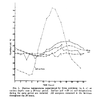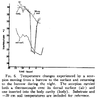- Joined
- Dec 18, 2018
- Messages
- 186
I found this article that actually measures the conditions inside the burrow of Hadrurus arizonensis in the wild.
https://esajournals.onlinelibrary.wiley.com/doi/10.2307/1935378

This graph shows the temperatures of three scorpions in their burrow, compared to air and soil temp 20cm into the substrate. These measurements were taken in June in Arizona. The first surprising thing is that while the temperature in the burrows stayed more mild than the outside air, it still averaged around 35C. Scorpion "A" was noted to not have dug a deep enough burrow and died during this temperature transient though.

This graph shows scorpion "B" leaving the burrow at about 2am, being exposed to the much cooler temperatures on the surface, then returning to the burrow around 4am and warming up. The authors noted that the peak temperature at 20cm was actually occurring just after the peak surface temperature outside, and existed slightly under the surface of the soil. This is because the sun was heating up the soil throughout the day, and that heat was gradually transferring deeper and deeper into the soil. At night, however, the surface would rapidly cool off, and so the entrance of the burrow quickly cooled, while the heat that had been transferred deep into the soil would then have to transfer back up to the surface or deeper into the earth. Combined, this means deep in the substrate stayed at a very constant warm temperature. I also want to note that these measurements were only done for 3 days in June, I would like to see the temperatures over a longer period of time and in the winter also.
The other important thing to note is the humidity.

This paper was measuring 55-70% humidity in the burrow, even though the surface humidity was occasionally less than 5%.
I've been deep diving on Arachnoboards as well and collecting all confirmed instances of Hadrurus successful molts.
https://arachnoboards.com/threads/hadrurus-arizonensis-molt.368555/
This thread was the most recent, care was on sand/soil mix, kept dry, no opportunity to burrow, with a constant water dish.
https://arachnoboards.com/threads/another-hadrurus-molt-experimental-substrate.125124/
OP had two hadrurus molt, one on sand, one on "moon sand", doesn't give much info about water but does say keeps them at 86F. The scorpion on sand did not burrow, the one on moon sand did. Another user said theirs molted when offered water in some way and they spray theirs.
https://arachnoboards.com/threads/hadrurus-arizonensis-molt.190082/
Two molts, 2/3 clay 1/3 sand, allowed to burrow, kept "hot and relatively humid" with a false bottom set up, water was "down one side every now and then to keep the humidity higher near the bottom"
https://arachnoboards.com/threads/h-arizonensis-successful-molt.354300/
Clay/sand mixture, allowed to burrow. Owner "When spring came around, every 2 weeks or so I would "make it rain" to mimic monsoons. I would also overflow the water dish a bit. I also used a long set of metal tongs to create a vertical channel in the substrate, which I poured some water down and allowed it to trickle down into the bottom layers. I would let it almost completely dry out, then repeat the process again."
https://arachnoboards.com/threads/h...a-desert-hairy-scorpion-dying-of-molt.298491/
Kept on a mixture of substrate, not allowed to burrow, had half solo cup "humidity hides", "I added about a 1/2 cup of water once a week to each cup on top straight through the substrate and misted over top seashells and other rocks to create tiny pools of water for them to drink if they were out and about." Does note their friend kept them similarly without success.
https://arachnoboards.com/threads/hadrurus-arizonensis-finally-molted.321283/
"Temperature approximately 82F at its burrow location during the day, with the rest of its cage being slightly cooler 76F nighttime for the entire cage. Air humidity bounces around between 20%-40%. It always has a full water dish and uses it fairly regularly (every 2 weeks or so from what I have seen, probably slightly less than that though). I would occasionally very lightly mist one part of the cage just to add a small amount of humidity but in reality that probably didn't do too much." Scorpion appears to have been kept on clay, but did not make it's own burrow. Molted in half a cup "humidity hide" similar to previous post.
That's all I could find. I also talked to someone on discord who said they got their Hadrurus arizonensis to molt to adulthood by having a constant water dish and regular spraying with a sand/soil mixture for substrate, but I obviously don't have a link for this. It seems the main constant was having water available and be provided. Only about half of them allowed their scorpions to make a burrow, the other half used some sort of hide. These scorpions were at various sizes and instars. More information or data would be appreciated.
https://esajournals.onlinelibrary.wiley.com/doi/10.2307/1935378

This graph shows the temperatures of three scorpions in their burrow, compared to air and soil temp 20cm into the substrate. These measurements were taken in June in Arizona. The first surprising thing is that while the temperature in the burrows stayed more mild than the outside air, it still averaged around 35C. Scorpion "A" was noted to not have dug a deep enough burrow and died during this temperature transient though.

This graph shows scorpion "B" leaving the burrow at about 2am, being exposed to the much cooler temperatures on the surface, then returning to the burrow around 4am and warming up. The authors noted that the peak temperature at 20cm was actually occurring just after the peak surface temperature outside, and existed slightly under the surface of the soil. This is because the sun was heating up the soil throughout the day, and that heat was gradually transferring deeper and deeper into the soil. At night, however, the surface would rapidly cool off, and so the entrance of the burrow quickly cooled, while the heat that had been transferred deep into the soil would then have to transfer back up to the surface or deeper into the earth. Combined, this means deep in the substrate stayed at a very constant warm temperature. I also want to note that these measurements were only done for 3 days in June, I would like to see the temperatures over a longer period of time and in the winter also.
The other important thing to note is the humidity.

This paper was measuring 55-70% humidity in the burrow, even though the surface humidity was occasionally less than 5%.
I've been deep diving on Arachnoboards as well and collecting all confirmed instances of Hadrurus successful molts.
https://arachnoboards.com/threads/hadrurus-arizonensis-molt.368555/
This thread was the most recent, care was on sand/soil mix, kept dry, no opportunity to burrow, with a constant water dish.
https://arachnoboards.com/threads/another-hadrurus-molt-experimental-substrate.125124/
OP had two hadrurus molt, one on sand, one on "moon sand", doesn't give much info about water but does say keeps them at 86F. The scorpion on sand did not burrow, the one on moon sand did. Another user said theirs molted when offered water in some way and they spray theirs.
https://arachnoboards.com/threads/hadrurus-arizonensis-molt.190082/
Two molts, 2/3 clay 1/3 sand, allowed to burrow, kept "hot and relatively humid" with a false bottom set up, water was "down one side every now and then to keep the humidity higher near the bottom"
https://arachnoboards.com/threads/h-arizonensis-successful-molt.354300/
Clay/sand mixture, allowed to burrow. Owner "When spring came around, every 2 weeks or so I would "make it rain" to mimic monsoons. I would also overflow the water dish a bit. I also used a long set of metal tongs to create a vertical channel in the substrate, which I poured some water down and allowed it to trickle down into the bottom layers. I would let it almost completely dry out, then repeat the process again."
https://arachnoboards.com/threads/h...a-desert-hairy-scorpion-dying-of-molt.298491/
Kept on a mixture of substrate, not allowed to burrow, had half solo cup "humidity hides", "I added about a 1/2 cup of water once a week to each cup on top straight through the substrate and misted over top seashells and other rocks to create tiny pools of water for them to drink if they were out and about." Does note their friend kept them similarly without success.
https://arachnoboards.com/threads/hadrurus-arizonensis-finally-molted.321283/
"Temperature approximately 82F at its burrow location during the day, with the rest of its cage being slightly cooler 76F nighttime for the entire cage. Air humidity bounces around between 20%-40%. It always has a full water dish and uses it fairly regularly (every 2 weeks or so from what I have seen, probably slightly less than that though). I would occasionally very lightly mist one part of the cage just to add a small amount of humidity but in reality that probably didn't do too much." Scorpion appears to have been kept on clay, but did not make it's own burrow. Molted in half a cup "humidity hide" similar to previous post.
That's all I could find. I also talked to someone on discord who said they got their Hadrurus arizonensis to molt to adulthood by having a constant water dish and regular spraying with a sand/soil mixture for substrate, but I obviously don't have a link for this. It seems the main constant was having water available and be provided. Only about half of them allowed their scorpions to make a burrow, the other half used some sort of hide. These scorpions were at various sizes and instars. More information or data would be appreciated.



